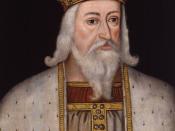I. Prelude to Disaster A. Economic difficulties came about in the later thirteenth century.
1. In the first decade, the countries of northern Europe experienced price inflation.
2. Sever weather was labeled as "The Little Ice Age."ÃÂ 3. Almost all for northern Europe suffered a terrible famine in 1315 to 1317.
B. An epidemic of typhoid fever carried away thousands.
1. In 1318, the disease hit cattle and sheep, reducing the population.
2. In 1321, another bad harvest brought death.
C. The province of Languedoc in France presents a classic example of agrarian crisis.
1. Torrential rains in 1310 ruined the harvest, harvest failed again in 1322 and 1329.
2. In 1302 to 1348, harvest failed 20 times.
D. Populations increased in the twelfth and thirteenth centuries, and large amounts of land had been put under construction.
1. In 1318, an infection attacked English sheep; in turn a lot of people were unemployed.
2. Unemployment encouraged people to turn to crime.
E. The government did not know how to solve their problems.
1. After Edward I died in 1307, Edward II ruled (1307-1327)-weak ruler.
2. Three sons of Phillip the Fair ruled France from 1314 to 1328.
3. In Germany, power went to the hands of the local rulers.
II. The Black Death A. In 1291 Genoese sailors had opened the Strait of Gilbraltat to Italian shipping by defeating the Moroccans.
1. Ships started carrying three masts instead of one.
2. Since the ships were on the sea all year round, the rats too were on the move, and rat transmitted diseases could spread easily.
3. Some think that the bubonic plague "the Black Death"ÃÂ, originated in China or South Asia around 1331, over the next fifteen years merchant and soldiers carried it over.
4. Others believe the plague was...


